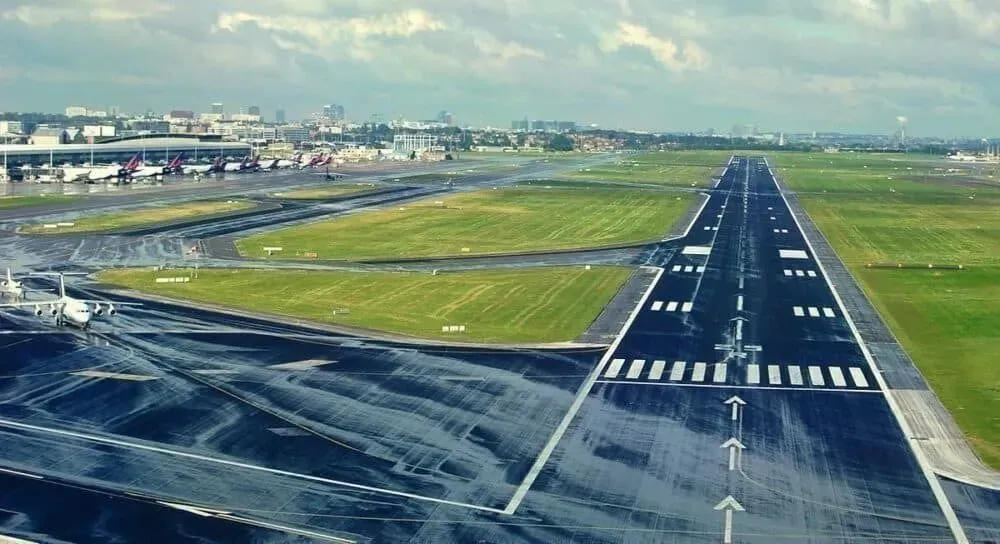Airport grass plays a crucial role in airport landscaping, creating a unique ecosystem that is often overlooked by travelers rushing to their destinations. Unlike the carefully manicured lawns of parks or residential yards, grass at airports is specifically designed to mitigate wildlife hazards while enhancing operational safety. The importance of grass at airports extends beyond aesthetics; it helps stabilize air currents and discourages birds, safeguarding aircraft during takeoff and landing. Moreover, effective grass maintenance preserves the turf’s health and density, which directly impacts flight safety and environmental balance. Understanding this vital aspect of airport infrastructure not only highlights the value of airport grass but also emphasizes the need for wildlife protection at airports and the intricate relationship between nature and aviation.
When we think of open spaces at airports, we often picture vast stretches of pavement rather than the green expanses of grass that surround them. This vital vegetation is not just for show; it serves critical functions that support both the airport’s operations and the local ecosystem. Turf management in these areas is particularly challenging, as it involves balancing aesthetics with the necessity of wildlife deterrence, allowing for smooth flight operations. Furthermore, the grass acts as a natural barrier against various environmental factors, helping to maintain the overall health of the airport’s landscape. By recognizing the attributes of airport turf, we can appreciate the nuanced relationship between aviation infrastructure and ecological stability.
The Vital Role of Grass Maintenance at Airports
Grass maintenance at airports is crucial not only for aesthetics but also for safety and ecological balance. Unlike conventional lawns, airport grass must be carefully cultivated and managed because it plays a significant role in the ecosystem of the airfield. Proper maintenance ensures that the grass remains robust and healthy, providing a habitat for essential soil organisms such as earthworms and insects, which contribute to the airport’s unique biodiversity. Regular mowing and care help to eliminate potential hazards, such as tall grass that could conceal wildlife, which poses threats to aircraft during takeoff and landing.
This specialized maintenance regime involves using specific techniques, equipment, and practices that differ substantially from those used in residential or commercial landscaping. For instance, the grass must be kept short to deter birds, which could lead to dangerous bird strikes. Therefore, airport grass maintenance is a blend of horticulture and environmental science intended to secure the airspace while creating a sustainable ecosystem that supports various species without compromising airport operations.
Importance of Airport Grass in Wildlife Protection
The importance of airport grass extends far beyond aesthetics; it plays a vital role in wildlife protection. By managing the types and lengths of grass, airport authorities can deter birds that might otherwise flock to the airfield, reducing the risk of bird strikes during critical phases of flight. The presence of grass, with its short stature and lack of hiding places, creates an environment that discourages birds while still providing essential coverage for ground insects, which are crucial for the ecosystem. This thoughtful design helps maintain the delicate balance between operational safety and environmental consideration.
Additionally, airport grass serves as a buffer, supporting insects and small creatures while minimizing the areas where larger wildlife can thrive. By keeping the landscape uniform and open, airports can prevent animals from nesting or foraging in dangerous zones. This proactive approach not only protects flights but also fosters a healthier ecosystem, demonstrating that airports can be both functional and environmentally conscious spaces.
Understanding the Airport Ecosystem Beyond the Runway
When examining the airport ecosystem, one realizes the intricate relationships between the grass, insects, and aircraft. The grass serves as a foundational element, supporting a myriad of insect life that, in turn, sustains larger predators within this unique habitat. The balance maintained by these organisms helps to ensure that the airport remains an effective operational space. For instance, the activity beneath the airport grass creates microhabitats that enable insects to thrive, which all contribute positively to the ecosystem’s health.
Furthermore, the regular turbulence caused by planes gives insects an unusual opportunity to adapt and survive. They utilize the gusts created by landing and departing aircraft to navigate their environment, illustrating an unexpected partnership between wildlife and aviation. The maintenance and management of airport grass thus play a pivotal role in fostering a resilient airport ecosystem, where the interactions of its many components ultimately support the safety and efficiency of air travel.
The Aesthetics and Functionality of Grass at Airports
The aesthetics of airport grass are often overlooked, but its visual appeal plays a practical role as well. A well-maintained grassy expanse can enhance the overall appearance of an airport, creating a positive impression for travelers, while also serving critical safety functions. Grass can reduce dust and erosion around runways and taxiways, contributing to better visibility and operational efficiency. The contrast between the manicured grass and the sleek lines of aircraft presents a unique visual harmony that cannot be attained with traditional asphalt surfaces alone.
Moreover, the grass is integral to managing stormwater runoff, which protects the surrounding environment from potential contaminants that could otherwise flow directly into local waterways. This practice not only contributes to better water management but also reflects the airport’s commitment to ecological stewardship and sustainability, reinforcing the idea that functionality and beauty can coexist effectively.
Challenges of Maintaining Grass at Airports
Maintaining grass at airports presents unique challenges, one of the primary ones being the need for constant vigilance against wildlife intrusion. Managing grass height, density, and species selection requires a comprehensive understanding of both horticulture and aviation safety. The combination of precise equipment and knowledgeable staff ensures that any potential issues—such as unwanted birds or insects—are promptly addressed before they can affect air travel.
Additionally, the environmental conditions around airports can be harsh, with activities from aircraft operations disrupting the growth patterns of grass. Factors such as high winds, jet blasts, and varying soil conditions call for specialized techniques in grass maintenance. Strategies such as aeration, overseeding, and the use of specific grass varieties that can withstand these conditions are essential for maintaining a healthy grassy environment at an airport.
Airport Grass as a Reflection of Personal Passion
For many, including those who manage airport grass, it is not just a job but a reflection of personal passion. The joy of cultivating and caring for the grass at airports can be deeply fulfilling, providing a unique opportunity to be part of an unseen aspect of air travel. Individuals who find beauty and fascination in airport grass often bring a distinctive perspective to their work, emphasizing the importance of creating a beautiful yet functional environment.
This reflection of passion can often lead to a deeper understanding and appreciation of the nuances involved in airport management. Workers become advocates for the grass, recognizing its role in the broader ecosystem and its importance in maintaining operational safety. Their dedication transcends traditional gardening as they appreciate this unique landscape for its hidden stories and the vital role it plays in the life of the airport.
The Impact of Air Traffic on Airport Grass Health
The health of airport grass is significantly influenced by air traffic activity. Aircraft takeoffs and landings generate winds and turbulence that can impact the health of the grass beneath them. In response, grass must be managed in a way that anticipates these disturbances, requiring ongoing monitoring and adjustment. Over time, the stress caused by repeated jet blasts can lead to bare patches, erosion, and in some cases, a decline in overall grass health, which can create a cascading effect on the airport ecosystem.
It is essential to approach the health of grass at airports with a long-term perspective, understanding that the interactions between planes and their environment can dramatically affect the grass’s durability. When flights are suspended, as seen during any major disruptions, the natural balance can be upset, resulting in adverse impacts on the ecosystem that depend on consistent air traffic for their immune response. This dynamic emphasizes the need for proactive care and ecological strategies that protect not only the grass but the entire airport environment.
Innovative Practices in Airport Landscaping
Innovative practices in airport landscaping focus on enhancing the ecological and aesthetic value of airport grass. Utilizing advanced agronomic techniques, airport management teams can implement eco-friendly practices, such as using native grass species that are more resilient to drought and local pests while requiring less maintenance. Innovations like natural pest repellents and organic fertilizers also contribute to creating a healthier grass ecosystem that protects both the environment and air traffic.
These cutting-edge methods not only promote the longevity of airport grass but also provide an educational platform for airport staff and visitors, highlighting the importance of sustainability in aviation. By incorporating these innovative landscaping practices, airports can serve as models for how to manage large spaces while prioritizing both ecological balance and operational safety, breathing new life into the understanding of airport landscaping’s contributions.
Narratives of Connection Through Airport Grass
The emotional connection to airport grass often transcends mere maintenance; it creates narratives that reflect deeper personal experiences. For many grass caretakers, their work is intertwined with memories of travel and adventure, as well as a lifelong fascination with flight. The sense of pride in maintaining a verdant landscape amid the buzz of airport operations fosters a unique bond with the environment, illustrating that even the most utilitarian settings can harbor beauty and complexity.
These personal stories enrich the broader narrative of airport grass, showing how it can bridge human experiences with the ever-evolving landscape of aviation. Every green blade of grass symbolizes moments of anticipation and reflection, linking passengers’ journeys to the simple yet profound act of maintaining the space where planes take flight. This intricate relationship reaffirms the idea that every component within the airport serves a purpose, grounding the fantastical experience of air travel with a sense of place and belonging.
Frequently Asked Questions
What is the importance of grass at airports?
Grass at airports serves a critical role in stabilizing air currents near the runway. Unlike parks and gardens where grass is often an afterthought, at airports, it actively helps untangle turbulent winds that can pose risks to landing and takeoff. Thus, maintaining healthy airport grass is crucial for operational safety.
How does airport landscaping incorporate grass maintenance?
Airport landscaping prioritizes grass maintenance to ensure a flat surface that deters birds from nesting, which could endanger flight safety. Regular mowing and care of the grass create an environment that supports the airports’ ecological balance while preventing wildlife-related hazards.
Can airport grass ecosystems support wildlife protection?
Yes, the grass ecosystems at airports can inadvertently support wildlife protection by creating an environment with fewer hiding spots for potential hazards like birds. The open grass surface discourages birds from approaching, thus enhancing safety for aircraft during operations.
What challenges do gardeners face in maintaining airport grass?
Gardeners maintaining airport grass must overcome challenges such as ensuring the grass is free of weeds or flowers that attract birds and insects. Additionally, they must contend with the unique environmental factors created by runways, including dust and turbulence from landing aircraft, which can impact grass health.
Why is regular grass maintenance essential at an airport?
Regular grass maintenance is essential at airports to prevent conditions that could lead to bird strikes, which are a significant threat to aviation safety. Well-maintained grass also stabilizes soil and air currents, ensuring a safer landing and takeoff experience for aircraft.
How does the airport grass contribute to the overall airport ecosystem?
The airport grass is a fundamental part of the airport ecosystem, providing a habitat for various insects while minimizing exposure to birds. This balance helps maintain the ecological integrity of the airport while simultaneously enhancing safety for aircraft operations.
What are the benefits of using grass instead of asphalt at airports?
Using grass instead of asphalt is beneficial for airports because it helps to manage air currents, reducing turbulence that could affect landings. Grass also contributes to environmental aesthetics and provides a natural solution for stabilizing soil, unlike asphalt, which can lead to runoff and environmental degradation.
How does grass maintenance impact airport operations during off-seasons?
Grass maintenance during off-seasons is vital to preserving the turf’s health and ecological balance. Neglecting this can lead to overgrowth of weeds or deterioration of the grass, making the airport susceptible to dust storms and visibility issues that can hinder flight operations.
What role does grass play in preventing bird strikes at airports?
Grass plays a significant role in preventing bird strikes at airports by acting as an uninviting habitat for nesting birds. The maintenance of grass combined with its low-profile growth deters birds from congregating in these areas, thereby reducing the risk of collisions with aircraft.
What specific maintenance practices are used for airport grass?
Airport grass maintenance includes regular mowing to keep the turf at an optimal height, aeration to encourage healthy root systems, fertilization to enrich soil nutrients, and pest control to manage harmful insects without attracting birds.
| Key Point | Explanation |
|---|---|
| Role of Grass at Airports | Grass serves a critical function in stabilizing air currents and prevents bird strikes by eliminating habitats for them. |
| Differences from Traditional Grass | Unlike park grass, airport grass is maintained without flower beds or bushes to minimize bird presence. |
| Ecology of the Airport Grass | The grass supports a unique ecosystem where insects thrive, adapting to avoid aircraft. |
| Impact of Disruption | When the airport closed post-terrorist attacks, the ecosystem collapsed, leading to the degradation of the grass. |
| Personal Attachment to Grass | The narrator shares a deep connection to airport grass, viewing it as a symbol of longing and identity. |
Summary
Airport grass is often overlooked, yet it serves crucial roles at airfields. This piece illustrates how the grass not only stabilizes air currents but also creates a unique ecological environment while providing a reflection of the narrator’s personal journey. The grass symbolizes resilience and connection to nature, offering insights into the often-unseen complexities of an airport’s ecosystem.



